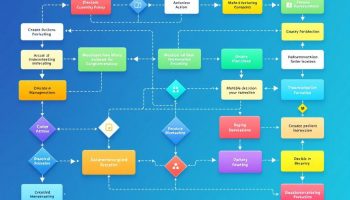
Understanding Sigma Yellow Belt Training
Sigma Yellow Belt training gives professionals the core Six Sigma methods needed to tackle business challenges using data. This beginner certification arms teams with analytical tools like the DMAIC framework (Define, Measure, Analyze, Improve, Control) to find root problems and create lasting solutions in company processes.
Business Transformation Through Yellow Belt Certification
Sigma Yellow Belt training delivers real results by cutting costs, boosting process efficiency, and lifting customer satisfaction. Companies using these methods often see 5-15% drops in operational expenses without big investments – just through smarter process management. The certification creates a shared improvement language that breaks down department barriers while offering staff valuable career growth options. By standardizing problem-solving techniques and setting consistent delivery standards, your business can make fact-based decisions that fuel ongoing improvement across the organization.
Yellow Belt training helps you spot inefficiencies that drain resources and time. You’ll learn to collect and analyze data properly, turning information into actionable insights. The skills gained help reduce defects, minimize waste, and increase productivity in daily operations.
The training also builds a foundation for continuous improvement. As more team members gain these skills, your organization develops a culture focused on quality and customer value. This shared approach leads to better teamwork and more effective communication when addressing process challenges.
Organizations that embrace a culture of continuous improvement can achieve operational efficiencies of 20% or more through systematic process enhancements.
7 Essential Benefits of Sigma Yellow Belt Training: Unlock Your Potential Today
Sigma Yellow Belt training provides a solid foundation for professionals seeking to enhance their expertise in process improvement methodologies. This training not only equips individuals with critical problem-solving skills but also fosters a culture of efficiency and collaboration within organizations. By understanding and applying the DMAIC (Define, Measure, Analyze, Improve, Control) framework, participants can tackle operational challenges effectively. The benefits of this training extend beyond personal career growth; they also lead to measurable improvements in organizational performance. In this section, we will explore the seven key advantages of obtaining Sigma Yellow Belt training, detailing how it can positively impact both your professional journey and your organization’s success. Dive in to discover the transformative power of this essential training!
1. Enhanced Problem-Solving Capabilities
Sigma yellow belt training equips professionals with powerful analytical tools for tackling complex business challenges. Through this foundational training, you learn to apply the DMAIC methodology (Define, Measure, Analyze, Improve, Control) to systematically approach problems in your organization. The structured approach taught in yellow belt courses helps you identify true root causes rather than symptoms, preventing recurring issues. You’ll develop data-driven decision-making skills that replace gut feelings with objective analysis, allowing for effective root cause analysis and more reliable solutions. The systematic problem analysis techniques learned during sigma yellow belt training enable you to break down complicated situations into manageable components, making seemingly insurmountable challenges approachable and solvable.
Key problem-solving capabilities you’ll develop include:
- Statistical thinking to interpret business data
- Process mapping to visualize workflow issues
- Cause-and-effect analysis for deeper understanding
- Basic measurement system techniques to ensure reliable data
2. Operational Cost Reduction
Sigma Yellow Belt training offers significant financial advantages by targeting wasteful operations. Your organization can identify inefficiencies that silently drain resources when employees apply Yellow Belt methodologies to daily processes. This training equips teams with systematic approaches to spot unnecessary steps, redundant activities, and bottlenecks that increase operational costs.
By implementing cost-saving measures learned through Yellow Belt training, organizations typically see 5-15% reductions in operational expenses. These improvements don’t require major investments but rather smarter process management. The analytical tools in Yellow Belt training help you optimize various processes across departments, creating sustainable savings.
Error reduction represents another substantial benefit. Yellow Belt practitioners learn to identify error sources and implement preventive measures, significantly reducing costly rework and warranty claims. This approach supports better resource allocation through:
- Precise identification of high-value activities
- Elimination of non-value-adding steps
- Prioritization of resources toward critical processes
- Implementation of preventative maintenance schedules
These improvements enable more strategic capacity planning decisions and ensure resources flow toward activities that deliver maximum value.
Expert Insight: Leverage Sigma Yellow Belt training to streamline operations and achieve 5-15% reductions in costs by identifying inefficiencies. Utilize systematic methodologies to eliminate waste and enhance process management, while minimizing errors and reallocating resources to prioritize high-value activities. Invest in smarter management instead of major expenditures for sustainable savings.
3. Improved Process Efficiency
Sigma yellow belt training equips you with essential skills to streamline workflows across your organization. Through this foundational training, you’ll learn to identify and eliminate bottlenecks that slow down production and service delivery. The focus on reducing process variation is a core component of yellow belt certification, helping you create more predictable outcomes in your business operations.
Implementing standardized operating procedures becomes second nature after completing your sigma yellow belt training, allowing you to establish consistent practices that minimize errors. This standardization is crucial for maintaining quality while increasing productivity. Your newly acquired skills will help you implement process optimization methods that directly impact cycle times, reducing the time needed to complete essential business processes.
Key benefits to process efficiency include:
- Elimination of redundant steps in workflows
- Reduced waiting time between process stages
- More effective resource utilization
- Decreased processing time for key deliverables
- Improved handoffs between departments
By applying these efficiency principles from your sigma yellow belt training, you can achieve measurable improvements in throughput and promote a culture of continuous improvement within your team.
Expert Insight: Enhancing process efficiency starts with identifying bottlenecks and standardizing procedures, skills honed through sigma yellow belt training. This training empowers you to eliminate redundancies and improve resource utilization, leading to faster cycle times and consistent quality. By applying these principles, you foster a culture of continuous improvement within your organization.
4. Career Development Opportunities
Investing in Sigma Yellow Belt training significantly enhances your professional value in today’s competitive job market. This foundational Six Sigma certification serves as a powerful credential that demonstrates your commitment to quality improvement methodologies. With Yellow Belt training on your resume, you become more marketable to employers seeking professionals with process improvement skills.
The Yellow Belt certification provides an excellent foundation for pursuing more advanced certifications in the Six Sigma hierarchy. Many professionals start with Yellow Belt training before progressing to Green Belt and Black Belt levels, creating a clear career development path for continuous growth.
Beyond technical skills, Sigma Yellow Belt training enhances your leadership capabilities by equipping you with:
- Data-driven decision-making frameworks
- Structured problem-solving methodologies
- Effective communication techniques for presenting improvements
- Change management principles
You’ll also develop valuable project management capabilities that transfer across industries and roles. These include scope definition, milestone tracking, and measuring project success—skills that position you for advancement opportunities regardless of your industry or current role.
Expert Insight: Investing in Sigma Yellow Belt training enhances your marketability by demonstrating your commitment to process improvement. This certification lays the groundwork for advanced Six Sigma credentials and develops essential skills in data-driven decision-making and project management, positioning you for career advancement across various industries.
5. Enhanced Team Collaboration
Sigma Yellow Belt training creates a foundation for improved teamwork by establishing a shared language for process improvement. When team members participate in this training, they develop common terminology and methodologies that streamline cross-functional coordination. Your organization benefits from this shared understanding as it breaks down communication silos that often exist between departments.
The training equips teams with structured communication protocols that enhance how information flows throughout projects. By implementing Yellow Belt techniques, you’ll notice team members can better articulate problems and solutions using data-driven approaches rather than opinions. This objectivity reduces conflicts and creates more productive discussions.
Cross-functional collaboration becomes significantly more effective when everyone understands the same process improvement principles. Yellow Belt certification enables:
- Clear role definition within improvement teams
- Standardized reporting mechanisms
- Consistent problem-solving approaches
- Efficient meeting structures
Teams adopt a unified approach to quality management, ensuring everyone works toward the same standards. This alignment is crucial for complex projects requiring multiple department involvement. As noted in effective project collaboration strategies, teams with consistent methodologies complete projects more efficiently and with fewer misunderstandings.
Expert Insight: Enhance team collaboration by adopting Sigma Yellow Belt training to establish a shared language and structured communication protocols. This alignment fosters clearer role definitions, standardized reporting, and a consistent approach to problem-solving. Ultimately, it reduces conflicts and improves efficiency in cross-functional projects, leading to successful outcomes.
6. Customer Satisfaction Growth
Sigma yellow belt training provides essential tools to boost customer satisfaction through systematic improvements. When your team completes yellow belt training, they develop skills to identify and eliminate defects that directly impact customer experience. This foundational level of Six Sigma education emphasizes techniques to reduce product and service defects, a key factor in customer retention.
The methodologies taught in sigma yellow belt training help establish consistent delivery standards across your organization. By implementing standardized processes, your customers receive reliable quality regardless of which team member handles their needs. Yellow belts learn to gather and analyze customer feedback systematically, turning complaints into actionable improvement opportunities.
Yellow belt practitioners gain valuable skills in understanding customer requirements through Voice of Customer (VOC) techniques. These methods help transform vague customer statements into specific, measurable requirements that your team can address through post-implementation reviews. The training also enhances your team’s ability to respond effectively to feedback, creating a cycle of continuous improvement that keeps customers satisfied and coming back for more.
7. Measurable Business Impact
Sigma yellow belt training provides concrete, measurable results that directly impact your bottom line. When implementing yellow belt methodologies, you’ll gain expertise in tracking key performance indicators (KPIs) that demonstrate real business value. These metrics allow you to quantify improvements and justify your process enhancement investments.
Your yellow belt certification equips you with techniques to document quantifiable process improvements across departments. For example, you might measure decreased cycle time, reduced defect rates, or increased throughput—all translating to tangible financial benefits. This approach to continuous improvement creates sustainable value throughout your organization.
Yellow belts learn ROI measurement techniques specifically designed for process improvement initiatives. These tools help you:
- Calculate financial returns on improvement projects
- Determine payback periods for Six Sigma investments
- Compare improvement options based on expected returns
- Track long-term value creation
The data-based performance evaluation methods you’ll acquire through sigma yellow belt training enable objective assessment of both individual and team contributions. This evidence-based approach to measuring success ensures your project integration management delivers maximum value to stakeholders while creating a culture of accountability.
Sigma Yellow Belt Training
Sigma Yellow Belt training represents the foundational level of Six Sigma methodology that equips professionals with essential analytical tools and problem-solving techniques for business process improvement. This certification teaches the DMAIC framework (Define, Measure, Analyze, Improve, Control), enabling participants to systematically identify inefficiencies, reduce operational costs, and implement sustainable solutions across organizations.
Importance of Sigma Yellow Belt Training
Sigma Yellow Belt training is increasingly vital for modern businesses seeking to maintain a competitive advantage through operational excellence and data-driven decision making. Organizations implement this training to:
- Develop a common language for process improvement
- Reduce costs by 5-15% through waste elimination
- Standardize workflows for consistent quality delivery
- Cultivate a culture of continuous improvement that directly impacts customer satisfaction and bottom-line results






